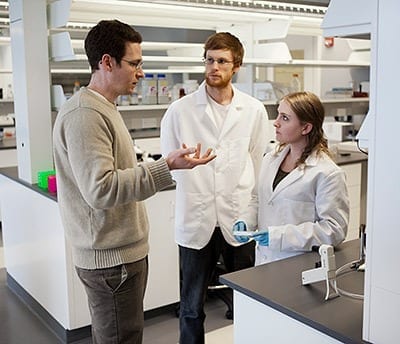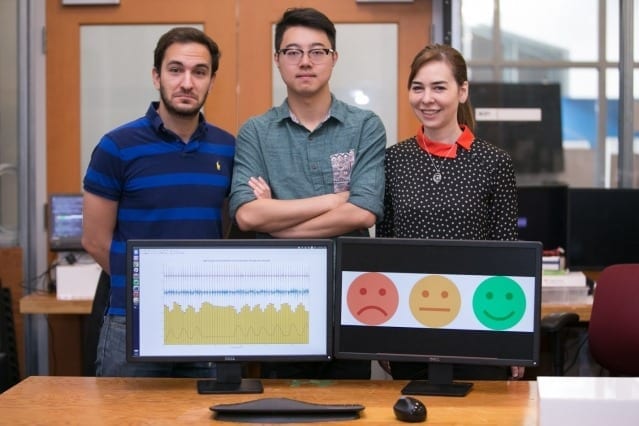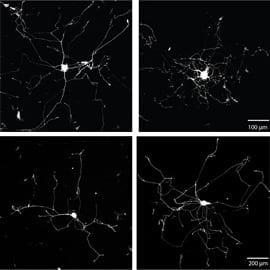
“This method makes antibiotics more potent, so hopefully it would reduce the mutant selection window,” Bryndilsen said.
As public health officials sound the alarm about the global spread of drug-resistant bacteria, researchers are working to develop more effective antibiotics to counter this dangerous trend. Now, results from a team including a Princeton University scientist offer a possible solution that uses the bacteria’s own byproducts to destroy them.
In a recent paper in the journal Nature Biotechnology, first author Mark Brynildsen, a Princeton assistant professor of chemical and biological engineering, reported that scientists can force bacteria to increase their production of a class of molecules called reactive oxygen species, which can either kill the bacteria outright or make them far more vulnerable to antibiotics. Bacteria normally produce reactive oxygen species during growth. Small amounts don’t hurt them because of certain protective enzymes within the bacteria, but too much of the substances can lead to “oxidative stress.” The researchers decided this weakness could be exploited.
“The question was, could we leverage this natural byproduct of growth?” Brynildsen said.
Scientists don’t fully understand the mechanism by which bacteria produce reactive oxygen species. Yet, Brynildsen and fellow members of the research team led by Professor James Collins at Boston University understood enough about the production in general to construct a number of feasible computer models. Essentially, the team analyzed reactive-oxygen production from thousands of mathematical models and looked for trends. That analysis revealed that certain enzymes allowed bacteria to reduce the levels of reactive oxygen species they created.
“This was what we were looking for, enzymes that when removed increased reactive-oxygen production independent of the uncertainty in the modeling,” Brynildsen explained.
The team analyzed a relatively benign strain of the E. coli bacteria, a common microbe whose variations can cause serious illness in humans. Using their computer model, the team predicted which bacterial genes are likely involved in regulating reactive oxygen species production. They then tested their predictions by deleting those genes in bacteria and confirming that the bacteria experienced increased production of reactive oxygen and an increased sensitivity to oxidants. The researchers then treated these bacteria with antibiotics and found that the organisms were in fact more vulnerable.
In some tests, the researchers added carboxin, a chemical compound often used as a fungicide, which mimicked the effects of altering one of the genes. They confirmed that the chemical amplified the killing effect of a common antibiotic, ampicillin. Brynildsen said that the research confirmed that although carboxin itself may not be suitable as a drug, chemicals with similar effects could be used in conjunction with antibiotics to increase the effectiveness of drug treatments against E. coli infections. Brynildsen and fellow researchers at Princeton plan to pursue similar research with other bacteria.
One of the possible benefits of increasing reactive-oxygen species concentrations is to allow current antibiotics to become more effective at lower dosages. In battling disease resistance, scientists try to deliver antibiotics in sufficient concentrations to kill bacteria without harming the patient. Problems arise when the maximum dose of an antibiotic that is safe for a person is too low to kill all the bacteria, allowing resistant organisms to survive. Epidemiologists call this gap the “mutant selection window.”
“This method makes antibiotics more potent, so hopefully it would reduce the mutant selection window,” Bryndilsen said.
The Latest Bing News on:
Antibiotic resistance
- Fears over emergence of new superbugs as antibiotic-resistant genes found in soil samples from across Scotlandon May 13, 2024 at 9:55 am
Organisms with genetic defences against our most commonly used medicines are everywhere in Scotland – not good news for human and animal health ...
- Significant rise in cases of drug-resistant disease in Bedfordshire new figures showon May 13, 2024 at 6:42 am
The Government has vowed to tackle the spread of a drug-resistant disease branded a ‘significant threat’ to public health.
- Scientist explains how antibiotics affect the guton May 13, 2024 at 4:30 am
Studies have shown that antibiotics can have a negative impact on your gut, causing symptoms such as nausea and vomiting. Dr Iveta Garaiova, a research scientist at ProVen Biotics, has revealed the ...
- Significant rise in cases of drug-resistant disease in Wirralon May 12, 2024 at 10:00 pm
It comes as the number of cases of Klebsiella in Wirral has risen significantly over the last six years, new figures show. UK Health Security Agency figures show 79 cases were recorded in the ...
- ‘Diary of a Dying Girl’: A mother’s loss launches a global effort to fight antibiotic resistanceon May 12, 2024 at 10:30 am
Diane Shader Smith’s daughter, like thousands who die each year from drug-resistant infections, might have been saved if treatment came faster. Her mission now is to make sure it does.
- A mother’s loss launches a global effort to fight antibiotic resistanceon May 11, 2024 at 6:00 pm
Diary Of A Dying Girl” excerpts Mallory Smith's own writings, which chronicle her 13-year battle against an antibiotic-resistant lung infection.
- Tackling the hidden pandemic of antibiotic-resistant superbugson May 11, 2024 at 10:24 am
These superbugs then transfer some drug-defeating genes to other bacteria causing a pandemic of superbugs. It’s a vicious cycle. But water is not our only worry. Recent reports of the use of ...
- Stem cell treatments in Mexico linked to drug-resistant meningitis, joint infectionson May 9, 2024 at 12:35 pm
Antibiotic-resistant meningitis or severe, long-lasting joint infections: That's what three U.S. "medical tourists" brought home after seeking out unapproved stem cell treatments in Mexico, according ...
- A global effort to fight antibiotic resistanceon May 9, 2024 at 8:52 am
In November 2017, days after her daughter Mallory Smith died from a drug-resistant infection at the age of 25, Diane Shader Smith typed a password into Mallory’s laptop. Her daughter gave it to her ...
- Changes in pig farming in the 20th century spread antibiotic-resistant Salmonella around the world, finds studyon May 9, 2024 at 7:44 am
Historical changes in pig farming led to the global spread of Salmonella, resistant to antibiotics—a new international study led by researchers at the University of Warwick suggests.
The Latest Google Headlines on:
Antibiotic resistance
[google_news title=”” keyword=”antibiotic resistance” num_posts=”10″ blurb_length=”0″ show_thumb=”left”] [/vc_column_text]The Latest Bing News on:
Mutant selection window
- The Best Video Streaming Services for 2024on May 8, 2024 at 5:00 pm
I’ve been writing and editing technology content for over five years, most recently as part of PCMag's consumer electronics team, though I also spent several years on the software team.
- The Best Retro Gaming Consoleson May 2, 2024 at 5:00 pm
I’ve been PCMag’s home entertainment expert for over 10 years, covering both TVs and everything you might want to connect to them. I’ve reviewed more than a thousand different consumer ...
- Best Target Deals: Score Discounts on a 128GB Meta Quest 2, Apple AirPods, and Moreon April 18, 2024 at 11:58 pm
This includes some incredible finds, such as the Beserk Deluxe Edition Volumes, Teenage Mutant Ninja Turtles: The Last Ronin, and plenty more as well. We'll leave some of our favorite picks just ...
- The best movies on Disney+ right now (April 2024)on April 11, 2024 at 5:00 pm
The villain leads an onslaught on Xavier and his school of mutants in an attempt to reprogram the Professor’s tracking computer, Cerebro, to assassinate every known mutant on the planet ...
- Fallout's Vault 4 Holds the Key to the Series' Futureon April 11, 2024 at 12:06 am
Absorb enough rads and you, too, can harness the power of unnatural selection! So a community of obvious mutants – as well as Maximus’s comments that mutants are common in the wasteland – is ...
- Teenage Mutant Ninja Turtles: Mutants Unleashed - Story, Gameplay & Release Windowon March 7, 2024 at 11:46 pm
When Teenage Mutant Ninja Turtles: Mutants Unleashed was first announced by Paramount, the game was targeting a 2024 release window. While A Heartful of Games has yet to narrow this down to a ...
- Hide or show translucent Selection Rectangle in Windows 11/10on August 5, 2020 at 11:13 pm
If prompted by UAC, click Yes to proceed. If Windows 11 shows a transparent rectangle on the screen, you need to disable the translucent selection rectangle option. For that, open the System ...
- Model Viewer Windowon March 4, 2017 at 3:07 pm
This resizable window provides plots and tables of actual values, model predictions, forecasts, and related statistics. The various plots and tables available are referred to as views. The following ...
- Dynamic Regressors Selection Windowon March 4, 2017 at 8:17 am
Use the Dynamic Regressors Selection window to select an input variable as a dynamic regressor. Access this window from the pop-up menu which appears when you select the Add button of the ARIMA Model ...
- A Mutation Story:on November 30, 2016 at 2:54 pm
Usually, both genes make a normal hemoglobin protein. When someone inherits two mutant copies of the hemoglobin gene, the abnormal form of the hemoglobin protein causes the red blood cells to lose ...
The Latest Google Headlines on:
Mutant selection window
[google_news title=”” keyword=”mutant selection window” num_posts=”10″ blurb_length=”0″ show_thumb=”left”]










